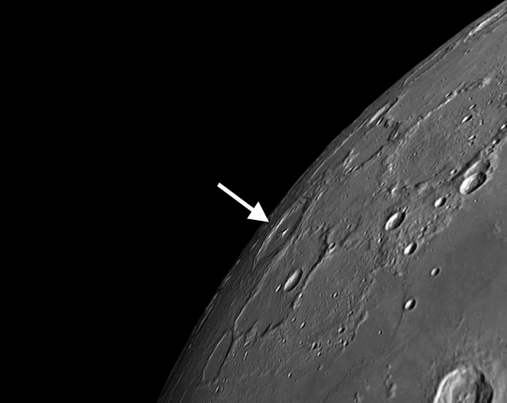This week we will highlight the moon crater Pythagoras, viewable on Tuesday evening.
 Pythagoras1 : [NW/C3; L=63°W] There is only a brief period during each lunation when Pythagoras is visible. It is a complex crater with two central mountain peaks, terraced walls, and internal features. It is an impressive 80 miles in diameter (compare to the more popular Copernicus at 58 miles.) Its spectacular rim mountains rise to an imposing three miles above its floor2! The central mountain peaks alone attain a height of one mile. Although it is close to the northwest limb and is substantially foreshortened, it is worth a visit. Try to catch it when the libration is favorable.
Pythagoras1 : [NW/C3; L=63°W] There is only a brief period during each lunation when Pythagoras is visible. It is a complex crater with two central mountain peaks, terraced walls, and internal features. It is an impressive 80 miles in diameter (compare to the more popular Copernicus at 58 miles.) Its spectacular rim mountains rise to an imposing three miles above its floor2! The central mountain peaks alone attain a height of one mile. Although it is close to the northwest limb and is substantially foreshortened, it is worth a visit. Try to catch it when the libration is favorable.
1 Pythagoras: (c. 580-500 BCE) Greek philosopher whose specialty was numbers and their meanings. He gave us the Pythagorean theorum and was one of the earliest to propose that the Earth was a sphere and that the Earth, Moon, and (alas!) the stars all revolved around the Sun.
2 To put this into perspective, these peaks would soar 7,000 feet higher than Colorado’s 14ers!
======================
It is highly recommended that you get a copy of Sky and Telescope’s Field Map of the Moon, the very finest Moon map available for use at the telescope. It is available for $10.95 at www.skyandtelescope.com and on Amazon. All features mentioned in this blog will be keyed to the grid on the Field Map and will look like this: Plato: [NW/D9]
Credits:
Courtesy of Gray Photography of Corpus Christi, Texas
Lunar photos: NASA / USGS / BMDO / LROC / ASU / DLR / LOLA / Moon Globe. Used by permission
- Rupes Cauchy: A Best Known Fault on the Moon - July 22, 2024
- Moon Crater Schickard – Crater Floor has Stripes - July 15, 2024
- Moon Craters Langrenus and Vandelinus - July 8, 2024